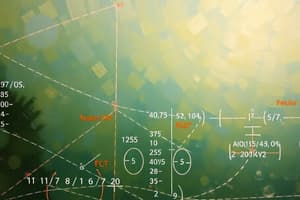Podcast
Questions and Answers
What is the term used to describe the distance travelled by a car from when the driver realizes the need to brake until they actually press the brake pedal?
What is the term used to describe the distance travelled by a car from when the driver realizes the need to brake until they actually press the brake pedal?
- Thinking distance (correct)
- Stopping distance
- Braking distance
- Reaction distance
What is the relationship between braking distance and speed?
What is the relationship between braking distance and speed?
- Braking distance increases as speed increases (correct)
- Braking distance decreases as speed increases
- Braking distance is not affected by speed
- Braking distance remains constant regardless of speed
A car is traveling at a constant speed of 60 km/h. Which of the following is a true statement about the car's motion?
A car is traveling at a constant speed of 60 km/h. Which of the following is a true statement about the car's motion?
- The car is experiencing a net force.
- The car's displacement is constant.
- The car is accelerating.
- The car's velocity is constant. (correct)
Which of the following factors can increase thinking distance?
Which of the following factors can increase thinking distance?
A book is lying on a table. What is the net force acting on the book?
A book is lying on a table. What is the net force acting on the book?
A ball is thrown vertically upwards. What is the acceleration of the ball at its highest point?
A ball is thrown vertically upwards. What is the acceleration of the ball at its highest point?
What is the term used to describe the distance travelled by a car from when the driver presses the brake pedal until the car comes to a complete stop?
What is the term used to describe the distance travelled by a car from when the driver presses the brake pedal until the car comes to a complete stop?
A 5 kg object is placed on a frictionless surface. A force of 10 N is applied to the object, what is the object's acceleration?
A 5 kg object is placed on a frictionless surface. A force of 10 N is applied to the object, what is the object's acceleration?
A 10 kg object is dropped from a height. What is the weight of the object?
A 10 kg object is dropped from a height. What is the weight of the object?
What is the relationship between the force applied to a spring and its extension, according to Hooke's Law?
What is the relationship between the force applied to a spring and its extension, according to Hooke's Law?
What is the term used to describe the point at which a spring no longer obeys Hooke's Law?
What is the term used to describe the point at which a spring no longer obeys Hooke's Law?
What is the difference between mass and weight?
What is the difference between mass and weight?
A heavy box is being pushed across a floor. What is the role of friction in this situation?
A heavy box is being pushed across a floor. What is the role of friction in this situation?
What is an example of elastic deformation?
What is an example of elastic deformation?
A rocket is launched into space. Which of Newton's laws explains why the rocket is able to accelerate?
A rocket is launched into space. Which of Newton's laws explains why the rocket is able to accelerate?
What is the unit of measurement for the gradient of a force-extension graph?
What is the unit of measurement for the gradient of a force-extension graph?
Which of the following statements accurately describes the region of a force-extension graph where the force is not proportional to the extension?
Which of the following statements accurately describes the region of a force-extension graph where the force is not proportional to the extension?
What is the principle of moments used to determine?
What is the principle of moments used to determine?
How does increasing the time taken for a passenger in a car to come to rest affect the force experienced by the passenger?
How does increasing the time taken for a passenger in a car to come to rest affect the force experienced by the passenger?
What is the relationship between the total momentum before and after a collision?
What is the relationship between the total momentum before and after a collision?
What is the formula for calculating the momentum of an object?
What is the formula for calculating the momentum of an object?
What is the formula for calculating the force exerted on an object?
What is the formula for calculating the force exerted on an object?
What is the unit of measurement for momentum?
What is the unit of measurement for momentum?
If the speed of an object increases over time, what can we say about its acceleration?
If the speed of an object increases over time, what can we say about its acceleration?
What is the unit of measurement for acceleration?
What is the unit of measurement for acceleration?
Which of these is NOT a true statement about a displacement-time graph?
Which of these is NOT a true statement about a displacement-time graph?
What information does the area under a velocity-time graph represent?
What information does the area under a velocity-time graph represent?
What is the relationship between velocity and speed?
What is the relationship between velocity and speed?
Which of the following is a TRUE statement about an object that has a constant velocity?
Which of the following is a TRUE statement about an object that has a constant velocity?
What is the formula for calculating average speed?
What is the formula for calculating average speed?
On a velocity-time graph, what does a horizontal line represent?
On a velocity-time graph, what does a horizontal line represent?
Flashcards
Vector
Vector
A quantity that has both magnitude and direction.
Scalar
Scalar
A quantity that has only magnitude, no direction.
Force
Force
An interaction that causes an object to change speed, shape, or direction, measured in Newtons.
Newton's First Law
Newton's First Law
Signup and view all the flashcards
Newton's Second Law
Newton's Second Law
Signup and view all the flashcards
Newton's Third Law
Newton's Third Law
Signup and view all the flashcards
Mass
Mass
Signup and view all the flashcards
Weight
Weight
Signup and view all the flashcards
Terminal velocity
Terminal velocity
Signup and view all the flashcards
Thinking distance
Thinking distance
Signup and view all the flashcards
Braking distance
Braking distance
Signup and view all the flashcards
Total stopping distance
Total stopping distance
Signup and view all the flashcards
Deformation
Deformation
Signup and view all the flashcards
Elastic deformation
Elastic deformation
Signup and view all the flashcards
Hooke's law
Hooke's law
Signup and view all the flashcards
Limit of proportionality
Limit of proportionality
Signup and view all the flashcards
Speed
Speed
Signup and view all the flashcards
Acceleration
Acceleration
Signup and view all the flashcards
Velocity
Velocity
Signup and view all the flashcards
Displacement
Displacement
Signup and view all the flashcards
Velocity-time graph
Velocity-time graph
Signup and view all the flashcards
Distance-time graph
Distance-time graph
Signup and view all the flashcards
Deceleration
Deceleration
Signup and view all the flashcards
Acceleration due to gravity
Acceleration due to gravity
Signup and view all the flashcards
Gradient
Gradient
Signup and view all the flashcards
Non-linear Force-Extension Graph
Non-linear Force-Extension Graph
Signup and view all the flashcards
Moment of a Force
Moment of a Force
Signup and view all the flashcards
Equilibrium
Equilibrium
Signup and view all the flashcards
Momentum
Momentum
Signup and view all the flashcards
Change in Momentum
Change in Momentum
Signup and view all the flashcards
Safety Features in Cars
Safety Features in Cars
Signup and view all the flashcards
Conservation of Momentum
Conservation of Momentum
Signup and view all the flashcards
Study Notes
Forces and Motion
- Speed: Defined as distance travelled per unit time. Constant speed indicates no acceleration; changing speed indicates acceleration or deceleration. Average speed = total distance / total time.
- Velocity: Speed in a given direction.
- Acceleration: Rate of change of velocity. Acceleration = change in velocity / time taken. ( final speed² = initial speed² + 2 × acceleration × distance)
- Units: Distance (m), time (s), speed/velocity (m/s), acceleration (m/s²).
- Displacement-Time Graphs:
- Gradient represents velocity.
- Horizontal line indicates stationary object.
- Curved line indicates changing velocity (acceleration or deceleration).
- Velocity-Time Graphs:
- Gradient represents acceleration.
- Negative gradient represents deceleration.
- Horizontal line indicates constant velocity.
- Area under the line represents the distance travelled.
- Curved line indicates changing acceleration.
Vectors and Scalars
- Vectors: Have magnitude and direction (e.g., displacement, velocity, acceleration, force).
- Scalars: Have only magnitude (e.g., distance, speed, time, energy).
Effects of Forces
- Forces: Change speed, shape or direction of a body. Measured in Newtons (N).
- Types: gravitational, electrostatic, friction (including air resistance).
- Resultant Force: Combined effect of multiple forces acting on an object. Added if in the same direction; subtracted if opposite.
- Newton's Laws of Motion:
- 1st Law: An object will remain at rest or continue to move at a constant velocity unless acted upon by a resultant force.
- 2nd Law: Force = mass × acceleration (F = ma).
- 3rd Law: For every action, there is an equal and opposite reaction.
- Mass: Measure of the amount of matter in an object (kg).
- Weight: Gravitational force acting on a mass (W = mg, where g is the gravitational field strength).
- Gravitational Field Strength: Strength of gravity at a particular location (e.g., on Earth, approximately 10 N/kg).
Motion Of A Falling Body Under Gravity
- Initial Motion: Only force acting is weight; therefore acceleration is constant.
- Increasing Air Resistance: Air resistance increases with speed and opposes motion. Resultant force decreases, and therefore, acceleration decreases.
- Terminal Speed: Resultant force is zero, speed is constant. (no acceleration).
Deformation
- Elastic Deformation: Object returns to its original shape when the load is removed (e.g., stretching a spring).
- Hooke's Law: For a spring, force is directly proportional to its extension. F=kx
Moments
- Moment of a force: Turning effect of a force. (Moment = Force x Perpendicular Distance from Pivot).
- Equilibrium: When resultant force and moment on an object are zero
Momentum
- Momentum: Product of mass and velocity (p = mv, measured in kg m/s).
- Conservation of Momentum: Total momentum before a collision equals total momentum afterwards.
- Force and Momentum: Force is the rate at which momentum changes (Force = change in momentum/time taken).
Thinking and Braking Distance
- Thinking Distance: Distance travelled during reaction time. Affected by speed, distractions, or tiredness.
- Braking Distance: Distance travelled between applying brakes and stopping. Affected by speed, vehicle mass, and road conditions.
Studying That Suits You
Use AI to generate personalized quizzes and flashcards to suit your learning preferences.




